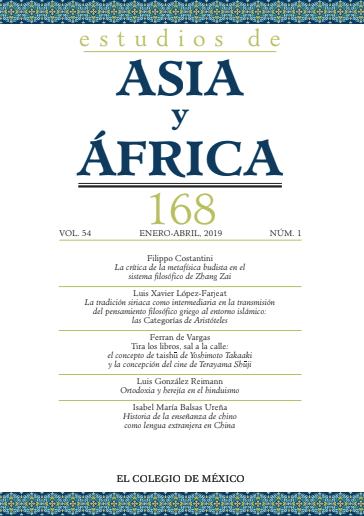Resumen
Conocer la dimensión artística de una ideología facilita la comprensión de su dimensión teórica y viceversa. En este sentido, se pretende analizar comparativamente el cine de Terayama Shūji, enconcreto su película Sho o suteyo machi e deyō [Tira los libros, sal a la calle], y la teoría de la taishū de Yoshimoto Takaaki, como componentes de la ideología de la Nueva Izquierda japonesa de finales de la década de 1960 y principios de la de 1970. Me centro en los paralelismos entre el cine de Terayama y la teoría de Yoshimoto respecto a su enfoque de la relación entre la figura del intelectual y las masas. Desarrollo este análisis partiendo de que, a pesar de la crítica a la ideología que albergan las obras de Yoshimoto y de Terayama, sus planteamientos contienen una fuerte carga política.
Referencias
Ando, T. (2014). Japan's New Left movements. Nueva York: Routledge.
Cassegard, C. (2008). From withdrawal to resistance. The rhetoric of exit in Yoshimoto Takaaki and Karatani Kojin. The Asia-Pacific Affairs, 6(3).
Centeno, M. (2012). Who can say that we not live like dogs? Retrospectiva de Shuji Terayama. Contrapicado. Escritos sobre cine. Recuperado de www.contrapicado.net.
Eagleton, T. (1991). Ideology. An introduction. Londres & Nueva York: Verso.
Fukuyama, F. (1992). The end of history and the last man. Nueva York: Free Press.
Furuhata, Y. (2013). Cinema of actuality. Japanese avant-garde filmaking in the season of image politics. Durham & Londres: Duke University Press.
Kelman, P. G. (2001). Protesting the national identity: the cultures of protest in 1960s Japan. (Tesis doctoral). University of Sidney, Sidney.
Kersten, R. (2009). The intellectual culture of postwar Japan and the 1968-1969 University of Tokyo struggles: Repositioning the self in postwar thought. Social Science Japan Journal, 12(2), 227-245.
Sakuta, K. (1978). The controversy over community and Autonomy. En J. V. Koschmann (Ed.), Authority and the individual in Japan. Citizen protest in historical perspective (pp. 220-249). Tokio: University of Tokyo Press.
Laclau, E. (1977). Politics and ideology in Marxist theory. Londres: NLB.
Morita, N. (2006). Avant-garde, pastiche, and media crossing: Films of Terayama Shūji. Waseda Global Forum, 3, 53-58.
Murakami, F. (2005). Postmodern, feminist and postcolonial currents in contemporary Japanese culture. A reading of Murakami Haruki, Yoshimoto Banana, Yoshimoto Takaaki and Karatani Kojin. Londres & Nueva York: Routledge.
Noonan, P. J. (2012). “Our dissolution”: Subjectivity, collectivity, and the politics of form in 1960s Japan. (Tesis doctoral). University of California, Berkeley.
Oguma, E. (2002). Minshu to aikoku (Pueblo y patriotismo). Tokio: Shinyosha.
Ridgely, S . C. (2011). Japanese counterculture. The antiestablishment art of Terayama Shūji. Minneapolis: University of Minnesota Press.
Sorgenfrei, C. F. (2005). Unspeakable acts: The avant-aarde theatre of Terayama Shūji and postwar Japan. Honolulu: University of Hawai’i Press.
Standish, I. (2011). Politics, porn and protest. Japanese avant-aarde cinema in the 1960s and 1970s. Nueva York: The Continuum International Publishing Group.
Yang, M. (2005). Yoshimoto Taka’aki, communal illusion, and the Japanese New Left. (Tesis de maestría). University of Toledo, Toledo.
_______. (2008). Yoshimoto Taka’aki’s Karl Marx: Translation and commentary. (Tesis doctoral). University of Toledo, Toledo.
Žižek, S. (1994). Mapping ideology. Londres & Nueva York: Verso.
Esta obra está bajo una licencia internacional Creative Commons Atribución-NoComercial-SinDerivadas 4.0.
Derechos de autor 2022 Estudios de Asia y África


